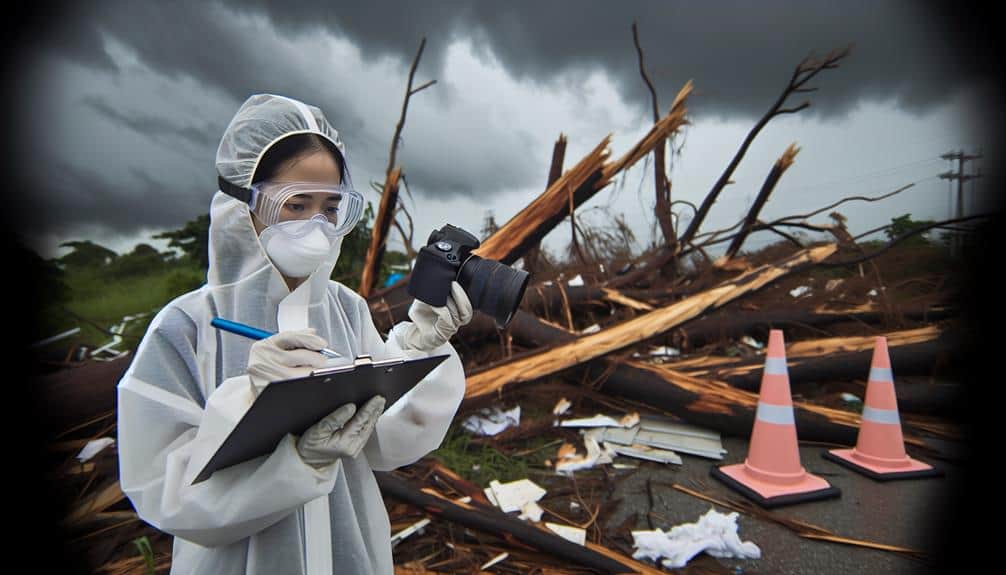We prioritize safety and accuracy in storm damage documentation by focusing on key areas such as water damage to walls, floors, foundations, and structural issues from impacts. Our toolkit includes digital cameras, documentation software, and precise measuring tools. Proper photo techniques, like using multiple angles and time-stamping, guarantee clear evidence. Structural compromises are recorded meticulously, highlighting cracks, foundation shifts, and roof damage. Safety protocols always include PPE and proper lighting. Thorough reports with photographs are shared with authorities to prompt urgent responses. By following this structured approach, you'll secure efficient, accurate inspections and stay prepared for further steps.
Key Points
- Use digital and physical tools, including cameras and notebooks, to document storm damage comprehensively.
- Capture photographs from multiple angles with proper lighting and time stamps for clear evidence.
- Identify and record structural compromises such as cracks, foundation shifts, and roof damage.
- Ensure data integrity with cloud-based storage solutions for efficient retrieval and detailed record-keeping.
Identifying Key Damage Areas
First, let's pinpoint the critical areas where storm damage is most likely to occur. We'll start with water damage, often the most pervasive issue. When water infiltrates a structure, it compromises walls, floors, and foundations, potentially leading to mold growth.
We must check basements, attics, and crawl spaces, as these areas are prone to water accumulation.
Next, electrical hazards are a significant concern. Storms can damage power lines, leading to shorts and potential fire risks. We should inspect breaker boxes, wiring, and outlets for any signs of water exposure or physical damage. Safety first—always make sure power is off before inspecting.
Window integrity is another crucial aspect. High winds can shatter glass or damage frames, allowing further water intrusion. We need to assess each window for cracks, broken seals, or complete breakage.
Lastly, tree impact is a frequent consequence of storms. Fallen trees can cause structural damage to roofs, walls, and external utilities. Inspect the property's perimeter for fallen trees or large branches that could have impacted the structure.
Essential Tools for Documentation
To thoroughly document storm damage, we'll need a set of reliable tools that guarantee accuracy and efficiency. Our toolkit should include both digital tools and physical tools to ensure thorough and precise documentation.
First, let's discuss digital tools. A high-quality camera or smartphone is indispensable for capturing clear images. Pair this with documentation software that allows us to organize and annotate photos efficiently. Apps designed for storm damage assessments can streamline the process, enabling us to link images directly to reports and create detailed photo albums. Digital measuring tools, such as laser distance meters, provide accurate dimensions of damaged areas, which are essential for detailed reports.
Next, physical tools are just as important. We should always carry a durable notebook and pens for on-the-spot notes and sketches. Measuring tapes and rulers are essential for manually gauging dimensions when digital tools aren't feasible. Safety gear, including helmets and gloves, ensures our protection while inspecting hazardous areas.
Photographic Evidence Techniques
Capturing clear and detailed photographic evidence is important for accurately documenting storm damage and supporting safety inspections. To guarantee we obtain the best possible images, we need to focus on proper angle selection. Photographing damage from multiple angles provides a thorough view, revealing details that might be missed from a single perspective.
Lighting techniques are equally vital in capturing clear evidence. Natural light is often best, but when it's not available, using a flashlight or portable light source can help illuminate the damage effectively. Avoid harsh shadows or overexposure, as they can obscure important details.
Time stamping each photo is essential for maintaining a chronological record of the damage. This feature can typically be activated within the camera settings, providing a clear timeline for inspectors and insurance assessors.
Equally significant is file organization. We should create a systematic approach to naming and categorizing our photos. This might involve grouping images by location, type of damage, or severity. Consistent labeling and storage practices not only streamline the inspection process but also guarantee that all evidence is easily accessible when needed.
Recording Structural Compromises
Let's start by identifying visible cracks in walls and ceilings, as these can indicate significant structural issues.
We'll then move to evaluating any shifts in the foundation, which are critical for determining the building's stability.
Identifying Visible Cracks
Identifying visible cracks is vital for evaluating structural integrity and ensuring safety during inspections. First, we need to focus on cracks identification to prevent potential hazards.
Begin by visually scanning all surfaces, including walls, ceilings, and floors. Note the location, length, and width of each crack. Use a flashlight to examine poorly lit areas, and a magnifying glass for finer details.
When documenting, photograph each crack from multiple angles, ensuring every image is clear and well-lit. Mark each crack with a unique identifier using chalk or tape, and record its dimensions. This step allows us to track any changes over time, which is crucial for evaluating ongoing structural integrity.
Safety precautions should never be overlooked during inspections. Always wear personal protective equipment, such as helmets and gloves, to protect against falling debris or sharp edges. If a crack appears to compromise the structure significantly, mark the area as hazardous and restrict access immediately.
Assessing Foundation Shifts
Evaluating foundation shifts is crucial for identifying structural compromises that could jeopardize building stability. We must meticulously examine the foundation for any signs of movement or displacement. Foundation cracks often indicate that the building has experienced significant stress, which can lead to a loss of structural stability if left unaddressed.
First, we inspect the perimeter of the foundation for horizontal and vertical cracks. Horizontal cracks suggest lateral movement, whereas vertical cracks indicate settlement issues. Both types of cracks can weaken the foundation and compromise structural stability. Using a digital level, we can measure any tilting or uneven settling that might suggest a larger problem.
Next, we document any separation between the foundation and the building structure. Gaps, even minor ones, can reveal significant shifts. We should photograph these gaps and note their dimensions to track any progression over time.
Documenting Roof Damage
When documenting roof damage, we need to systematically record any structural compromises to guarantee accurate safety inspections.
First, we should start with a thorough roof inspection, noting any visible signs of damage such as missing shingles, cracks, or punctures. These indicators are critical for a detailed damage assessment.
Next, let's assess the roof's structural integrity. We should examine the trusses and rafters for signs of warping, splitting, or other structural deformations. This step is essential for determining the load-bearing capacity of the roof, which directly impacts the building's safety.
Photographic evidence is necessary. We should take high-resolution images from multiple angles, capturing both wide shots of the overall roof and close-ups of specific damage points. These photos will serve as a visual record, aiding in future assessments and insurance claims.
Additionally, we need to document any signs of water intrusion. This includes checking for stains, mold, or dampness in the attic or ceiling below the roof. Water damage often indicates deeper structural issues that require immediate attention.
Safety Protocols During Documentation

Maintaining our team's adherence to strict safety protocols during storm damage documentation is vital for preventing injuries and preserving accurate records. First and foremost, we must prioritize safety measures. Each team member should wear suitable personal protective equipment (PPE), including helmets, gloves, and high-visibility vests. Additionally, we need to guarantee proper lighting in all areas we inspect to lessen the risk of accidents and to clearly capture the extent of damage.
Proper data organization is essential for seamless documentation. We should methodically capture images and notes, labeling each file with exact details such as the date, time, and location. Utilizing robust file storage solutions, like cloud-based systems, will help us maintain data integrity and accessibility. This secures that all team members can quickly find and review the information when needed.
Reporting Findings to Authorities
Having meticulously recorded the storm damage, we must now share our findings with the appropriate authorities to guarantee prompt and effective response. Our communication strategies should be clear, concise, and include all necessary details.
First, we identify the relevant authorities, such as local government agencies, emergency management offices, and insurance companies. We prepare a detailed report that includes photographic evidence, thorough descriptions, and any immediate safety concerns. It's crucial to use standardized forms where applicable to avoid any misinterpretation of data.
Our report should emphasize critical areas needing urgent attention, allowing authorities to prioritize their resources effectively. Next, we implement follow-up procedures to confirm the authorities have received and acknowledged our report. This might involve phone calls, emails, or even in-person meetings. Consistent follow-up ensures our documentation isn't overlooked and that actions are being taken.
We must be mindful of the legal implications and liability considerations of our documentation process. Accurate and comprehensive reporting helps protect us from potential liability issues. By providing authorities with precise information, we help streamline the response effort, ultimately aiding in quicker recovery and ensuring community safety.
Our role is crucial in this chain of communication and responsibility.
Frequently Asked Questions
How Should I Handle Insurance Claims After Storm Damage Is Documented?
We should promptly contact our insurance company to start the claim process. During insurance negotiation, let's make sure we provide accurate documentation, follow up regularly, and stay informed about our policy terms to achieve best results.
What Steps Should I Take if I Find Hazardous Materials?
Did you know 25% of storm debris can contain hazardous materials? First, we should guarantee safe hazardous material disposal. Second, conduct an environmental impact assessment to mitigate potential risks. Let's act swiftly and responsibly to protect our community.
Can I Hire Professionals to Document Storm Damage for Me?
Yes, we can hire professionals for storm damage documentation. Their expertise guarantees documentation accuracy, providing us with detailed, reliable reports. This professional assistance allows us to focus on our priorities while maintaining safety and compliance.
How Do I Differentiate Between Minor and Severe Damage?
Did you know that 40% of storm damage goes unnoticed initially? We can differentiate minor and severe damage using assessment criteria and a severity scale. Minor damage affects aesthetics, while severe damage compromises structural integrity and safety.
What Are the Common Mistakes to Avoid During Storm Damage Documentation?
Common mistakes include lacking proper organization, missing photos, and not noting details. We need to guarantee timely submission, double-check information, and maintain clear, precise records to avoid errors and secure accurate storm damage documentation.


